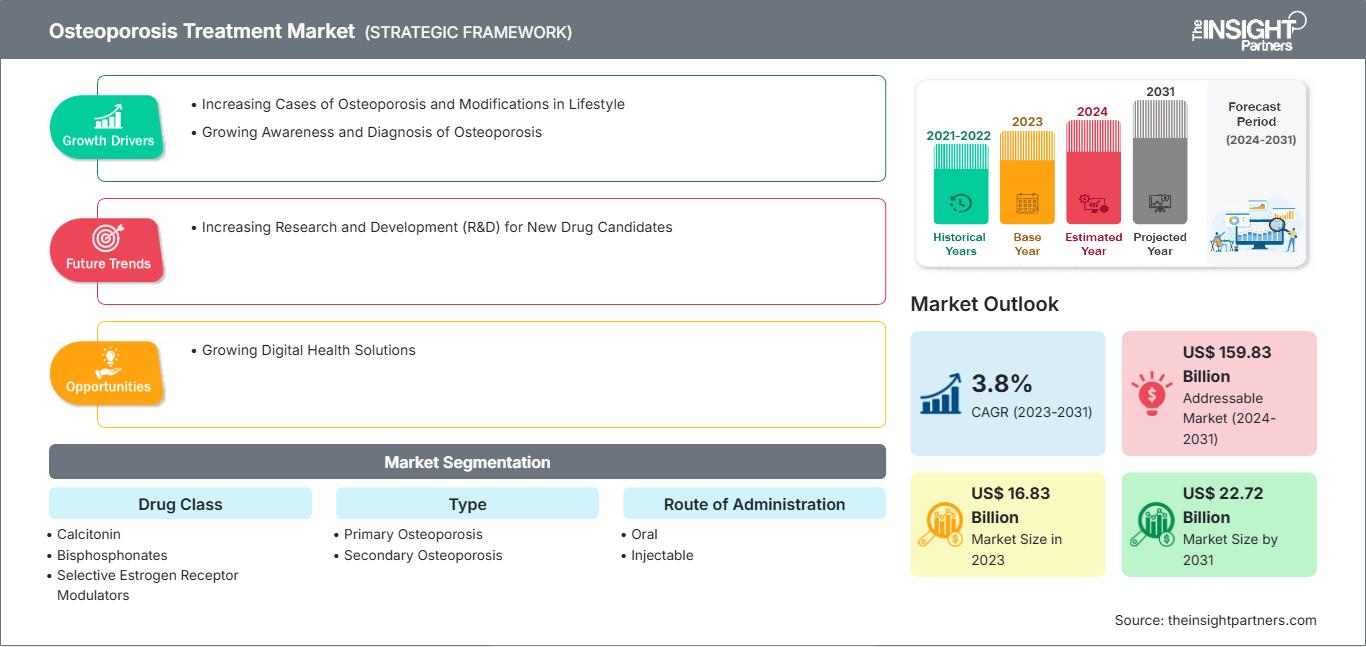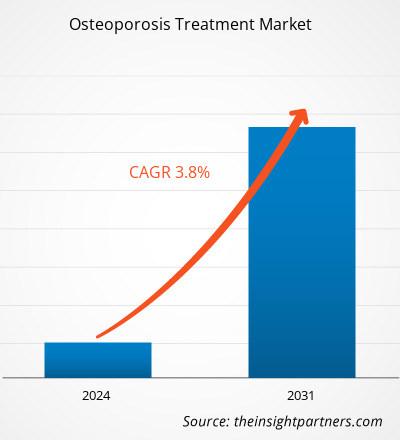骨粗鬆症治療市場規模は、2023年の168億3,000万米ドルから2031年には227億2,000万米ドルに急増すると予測されており、2023年から2031年にかけて年平均成長率(CAGR)3.8%を記録すると見込まれています。アナリストの視点:
本レポートには、現在の骨粗鬆症治療市場動向と予測期間中のその予測可能な影響に基づく成長見通しが含まれています。骨粗鬆症は骨を脆くする原因となり、軽い転倒でも骨折につながる可能性があり、生活の質に影響を与えます。早期発見・早期治療は骨粗鬆症の進行を遅らせ、あるいは阻止するのに役立ち、骨折のリスクを軽減します。したがって、骨粗鬆症の有病率は診断の必要性を高め、結果として骨粗鬆症治療市場の成長を後押しします。骨粗鬆症は主に女性に見られ、閉経期のホルモン変化が骨密度に影響を与えることが原因です。ホルモン変化以外にも、関節リウマチ、骨粗鬆症の家族歴、骨の強度に影響を与える薬剤の長期使用など、高齢者の骨粗鬆症リスクを高める要因があります。国際骨粗鬆症財団によると、骨粗鬆症患者の大多数のうち、25%が女性、5%が65歳以上の男性です。
市場概要:
骨粗鬆症は、男性、閉経後女性、高齢者層における骨折リスクの高い進行性疾患です。骨粗鬆症患者は特に、骨、股関節、前腕、脊椎、手首の骨折を起こしやすい傾向があります。そのため、骨密度を低下させ、骨折につながる代謝性疾患と言われています。治療薬としては、ビスホスホネート、ホルモン療法、デノスマブ、そして様々な栄養補助食品が挙げられますが、これらに加え、運動量の増加やカルシウムを豊富に含む食事といった生活習慣の改善も推奨されます。骨粗鬆症治療市場の成長を牽引する主な要因としては、創薬・開発への医療費支出の増加と、骨粗鬆症治療薬に関する認知度の高まりが挙げられます。
要件に合わせてレポートをカスタマイズ
レポートの一部、国レベルの分析、Excelデータパックなどを含め、スタートアップ&大学向けに特別オファーや割引もご利用いただけます(無償)
骨粗鬆症治療市場: 戦略的洞察

- このレポートの主要な市場動向を入手してください。この無料サンプルには、市場動向から見積もりや予測に至るまでのデータ分析が含まれます。
市場の牽引役:骨粗鬆症患者の増加とライフスタイルの変化が市場成長を促進
レポートの一部、国レベルの分析、Excelデータパックなどを含め、スタートアップ&大学向けに特別オファーや割引もご利用いただけます(無償)
骨粗鬆症治療市場: 戦略的洞察

- このレポートの主要な市場動向を入手してください。この無料サンプルには、市場動向から見積もりや予測に至るまでのデータ分析が含まれます。
骨粗鬆症の罹患率は世界中で増加しており、その主な原因は、不適切なライフスタイル、不健康な食生活、運動不足、カルシウムとビタミンDの摂取不足、ホルモンバランスの乱れです。国際骨粗鬆症財団によると、骨粗鬆症による骨折は年間890万件以上発生しており、3秒ごとに1件の骨折が発生しています。また、世界中で2億人の女性が骨粗鬆症に罹患していると推定されています。高齢化人口の増加も、骨粗鬆症治療市場の成長を促進する重要な要因です。Labiotech誌に掲載された研究「骨粗鬆症研究の進歩」によると、約1,000万人の米国人が骨粗鬆症を患っています。約4,400万人が骨密度が低く、骨粗鬆症のリスクが高まっています。骨粗鬆症を発症するリスクは加齢とともに著しく増加します。 50歳以上の成人は骨折リスクが高いと推定されています。米国では、毎年股関節骨折を患う65歳以上の成人の4分の3が女性であり、股関節骨折患者の約15~36%が1年以内に死亡すると推定されています。ホリスティックヘルスとウェルネスへの関心が高まるにつれ、骨密度スキャンを含む定期的な健康診断の導入が促進されています。個人が積極的に骨の健康状態を監視するようになるにつれ、早期診断と介入の重要性が高まり、市場の拡大をさらに促進しています。骨粗鬆症治療市場は、骨の健康に関する意識の高まりから大きな推進力を受けており、予防および治療ソリューションの需要が高まっています。
セグメント分析:
骨粗鬆症治療市場の分析は、薬物クラス、タイプ、投与経路、流通チャネルという以下のセグメントを考慮して実施されています。
薬物クラスに基づいて、骨粗鬆症治療市場は、RANKL、ビスホスホネート、選択的エストロゲン受容体モジュレーター(SERM)、ホルモン療法、その他に分類されています。RANKLセグメントは2023年に最大の市場シェアを占めました。しかし、ホルモン療法セグメントは2023年から2031年の間に最高のCAGRを記録すると予測されています。ビスホスホネートセグメントも、骨粗鬆症治療市場でかなりのシェアを占めています。アレンドロン酸やゾレドロン酸などの化合物を含むビスホスホネートは、骨吸収を抑制し、骨密度を高め、骨折リスクを最小限に抑える効果があることが証明されています。 豊富な臨床実績、規制当局の承認、経口および静脈内製剤の利用可能性により、医療専門家に好まれる選択肢となっています。 さらに、費用対効果が高く、包括的な保険適用範囲があることも、骨粗鬆症治療市場での幅広い採用に貢献しています。
市場は、タイプ別に原発性骨粗鬆症と続発性骨粗鬆症に分かれています。 2023年には、原発性骨粗鬆症セグメントが骨粗鬆症治療市場でより大きなシェアを占めました。 原発性骨粗鬆症は加齢に伴って発生し、骨の再生が遅くなります。 国立医学図書館に掲載された「閉経後女性における原発性骨粗鬆症と低骨量の有病率および関連リスク要因」と題された研究によると、世界中で50歳以上の女性の30%が骨粗鬆症を患っています。年間の骨折の8~9%は骨粗鬆症が原因であることが知られています。さらに、70歳以上の男女は骨の形成と減少のバランスが崩れ、腰痛、生活の質の低下、日常生活の支障につながります。
投与経路に基づいて、骨粗鬆症治療市場は経口と注射に分かれています。2023年には、注射剤セグメントが骨粗鬆症治療市場で最大のシェアを占めました。注射剤セグメントは、2023年から2031年にかけて最も高いCAGRを記録すると予想されています。市場における注射剤セグメントの優位性は、薬物送達方法としての有効性と信頼性に起因しています。注射による治療は、薬剤が血流に直接入り込むことを可能にし、迅速かつ予測可能な吸収をもたらします。これは骨粗鬆症治療における重要な利点です。さらに、一部の骨粗鬆症治療薬は注射剤のみで入手可能であり、その市場シェアをさらに押し上げています。自己注射に対する患者のコンプライアンス向上と革新的な薬剤送達ソリューションの継続的な開発により、注射剤セグメントは強力な市場地位を維持する態勢が整っています。
地域分析:
骨粗鬆症治療市場レポートの対象地域には、北米、ヨーロッパ、アジア太平洋、中東およびアフリカ、南米および中米が含まれます。北米の市場規模は2023年に82億6,000万米ドルと評価され、2031年には112億6,000万米ドルに達すると予測されています。また、2023年から2031年にかけて3.9%のCAGR(年平均成長率)を記録すると見込まれています。この地域における市場成長を牽引する主な要因の一つは、高齢化が著しく、骨粗鬆症に対する意識が高まっていることです。第二に、高度な医療インフラと医療サービスへの包括的なアクセスにより、タイムリーな診断と治療が可能になっています。さらに、大手製薬企業の存在と継続的な研究開発活動が、革新的な治療法の導入を促進しています。最後に、有利な償還政策と保険適用が、骨粗鬆症治療を求める患者をサポートし、北米における骨粗鬆症治療市場の活性化につながっています。
アジア太平洋地域の骨粗鬆症治療市場は、4.7%という最も高いCAGRを記録すると予想されています。この地域、特にインドや中国などの国々は、大規模な製薬産業の拠点となっています。中国は医薬品製造の中心地です。この地域の市場成長予測は、中流階級の増加と医療へのアクセス向上に起因しています。さらに、医療インフラの改善と医薬品セクターの台頭により、アジア太平洋地域は骨粗鬆症治療市場の大幅な成長と発展の拠点となっています。
骨粗鬆症治療市場の地域別分析
予測期間を通じて骨粗鬆症治療市場に影響を与える地域的な傾向と要因は、The Insight Partnersのアナリストによって詳細に説明されています。このセクションでは、北米、ヨーロッパ、アジア太平洋、中東・アフリカ、中南米における骨粗鬆症治療市場のセグメントと地域についても説明します。
骨粗鬆症治療市場レポートの範囲
| レポート属性 | 詳細 |
|---|---|
| の市場規模 2023 | US$ 16.83 Billion |
| 市場規模別 2031 | US$ 22.72 Billion |
| 世界的なCAGR (2023 - 2031) | 3.8% |
| 過去データ | 2021-2022 |
| 予測期間 | 2024-2031 |
| 対象セグメント |
By 薬物クラス
|
| 対象地域と国 | 北米
|
| 市場リーダーと主要企業の概要 |
|
骨粗鬆症治療市場のプレーヤー密度:ビジネスダイナミクスへの影響を理解する
骨粗鬆症治療市場は、消費者の嗜好の変化、技術の進歩、製品効果に対する認知度の高まりといった要因によるエンドユーザーの需要増加に牽引され、急速に成長しています。需要の増加に伴い、企業は製品ラインナップの拡充、消費者ニーズへの対応のための革新、そして新たなトレンドの活用を進めており、これが市場の成長をさらに加速させています。

- 入手 骨粗鬆症治療市場 主要プレーヤーの概要
ファイザー社、アムジェン社、キャディラ・ファーマシューティカルズ社、イーライリリー・アンド・カンパニー、第一三共株式会社、テバ・ファーマシューティカルズ社、旭化成株式会社、ノバルティスAG、中外製薬株式会社、帝人ファーマ株式会社は、本骨粗鬆症治療市場レポートで紹介されている主要プレーヤーの一部です。
最近の動向:
骨粗鬆症治療市場で事業を展開している企業は、合併や買収を主要な成長戦略として採用しています。各社のプレスリリースによると、最近の市場動向は以下のとおりです。
- 2021年10月、大手バイオテクノロジー企業であるエンテラ・バイオは、中期段階の経口骨粗鬆症薬製剤研究の主要データを発表しました。同社はこの研究の第3相登録を進めている。
- 2021年8月、インド医薬品管理総局(DCGI)は、成人の骨粗鬆症の治療を適応とするバイオシミラー薬デノスマブについて、Enzene Biosciences Ltdに販売承認(MA)を与えた。
- 2021年1月、ロンドンに本社を置く製薬会社Theramexは、ヨーロッパで骨粗鬆症治療薬Livogivaを発売した。
- 過去2年間の分析、基準年、CAGRによる予測(7年間)
- PEST分析とSWOT分析
- 市場規模価値/数量 - 世界、地域、国
- 業界と競争環境
- Excel データセット
最新レポート
お客様の声
購入理由
- 情報に基づいた意思決定
- 市場動向の理解
- 競合分析
- 顧客インサイト
- 市場予測
- リスク軽減
- 戦略計画
- 投資の正当性
- 新興市場の特定
- マーケティング戦略の強化
- 業務効率の向上
- 規制動向への対応




















 無料サンプルを入手 - 骨粗鬆症治療市場
無料サンプルを入手 - 骨粗鬆症治療市場